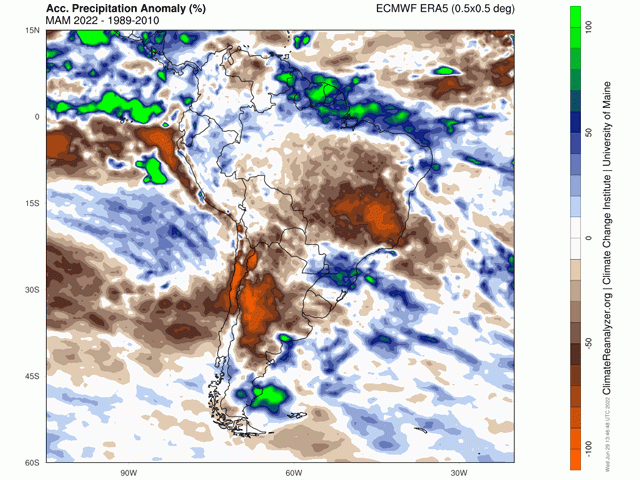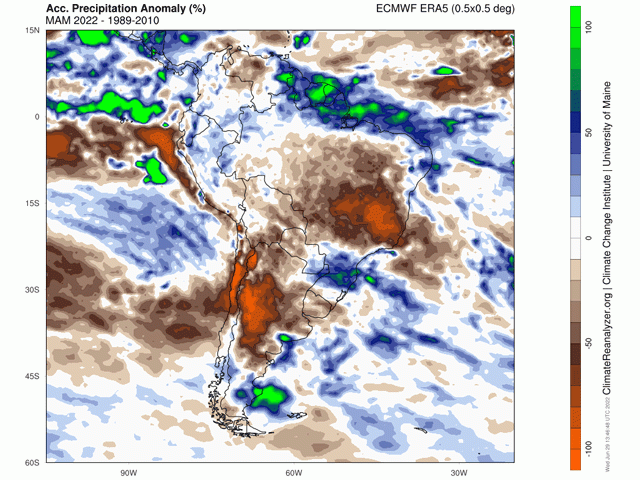South America Calling
Brazil's Safrinha Season Weather Recap
The weather's impact on the safrinha (second) corn season is essentially over in Brazil. Harvest is well underway in the state of Mato Grosso, the largest corn production state in Brazil. Around 42% of its corn harvest is complete as of June 25 according to the National Supply Company (Conab) in Brazil. While the agency lists Parana, the second largest safrinha corn producing state, at only 3% complete, the government agency in that state is farther ahead at 6% as of June 27 with more than half of the remaining crop, 55%, mature and ready to be harvested. Rains now will mostly hinder harvest than improve filling grains in the country. We'll take a look now at how the weather conditions changed for the country and how that might affect their final production.
La Nina brought a stark contrast between central and southern growing regions in the first-crop soybean season. La Nina typically leads to a delayed start to the wet season in central Brazil in their spring season, but this year it started on time. That put summer corn planting on track to occur in the normal window, late January through February.
During the soybean season, northern and central Brazil saw widespread heavy and continuous rainfall that filled soil profiles with ample and sometimes too much moisture, which delayed planting just a little bit. Farther south, from southern Mato Grosso do Sul to Rio Grande do Sul, drought gripped the region and delayed planting of soybeans. The drought hastened crop development though, and planting of safrinha corn mostly occurred on time.
P[L1] D[0x0] M[300x250] OOP[F] ADUNIT[] T[]
As the summer turned to fall, weather conditions quickly flip-flopped. Rains tapered off rather rapidly in mid-March in central Brazil, with only isolated showers for the rest of the month. In contrast, cold fronts moving north from Argentina into southern Brazil stalled, giving a quick boost to soil moisture that continued through April and May.
Back to the north, the waning showers essentially shut off in mid-April, more than two weeks before the average end to the wet season that occurs in the first few days of May. Corn in Mato Grosso and Goias were mostly in the late development and early pollination stages when the rains shut down, though soil moisture had been falling prior to that point. The crop in central Brazil needed to go through most of the season relying on subsoil reserves, which were plentiful, while battling temperatures routinely in the lower to middle 30s Celsius (middle 80s to middle 90s Fahrenheit).
In the south, that was not the case. Frequent precipitation events and cooler temperatures tempered moisture or heat stress for much of the season, though temperatures were a bit too cold for some areas. In mid-May and again in early June, there were risks of frosts across the southern states. That is a typical concern during a La Nina event and came rather early this year, while corn was pollinating and in early grain-fill. Some of the crop had yet to reach pollination before the first event. Thankfully for producers there, the cold was limited in corn-producing areas. While the impact is still being determined and will not be known until more of the harvest is in, it is likely that the frosts were localized and limited.
Like the first-crop soybean season, there was a stark difference from south to north where weather conditions were favorable and where they were unfavorable. It just so happens that those conditions were completely flipped from where they were from one season to the next. Central growing areas had good weather for their soybean crop, but poor conditions for the safrinha corn crop. Southern areas had poor conditions for their soybean crop but made up for it with good conditions for their safrinha crop.
Weather may have been unfavorable for the crop in the highest production areas of central Brazil, but weather conditions in Brazil in 2022 are nowhere near the poor conditions from last year's crop when the entire region went dry and suffered through three separate widespread frost events. As reported by Farmdoc Daily, Conab expects yields in Brazil to be roughly 30% higher than in 2021. A roughly 10% increase in planted acreage will also aid in the higher production values. https://farmdocdaily.illinois.edu/…
To find more international weather conditions and your local forecast from DTN, head over to https://www.dtnpf.com/…
John Baranick can be reached at john.baranick@dtn.com
(c) Copyright 2022 DTN, LLC. All rights reserved.






Comments
To comment, please Log In or Join our Community .